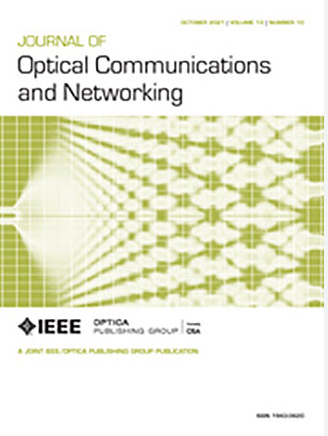基于智能学习的片上光网络路由算法
IF 4
2区 计算机科学
Q1 COMPUTER SCIENCE, HARDWARE & ARCHITECTURE
引用次数: 0
摘要
光片上网络(ONoCs)在芯片核心互连中起着至关重要的作用。目前,传输损耗是影响互联网络规模的主要限制因素。因此,降低传输损耗对于优化onoc的运行效率和规模是非常重要的。尽管在减少传输损耗方面已经取得了重大进展,但仍需要进一步工作来提高ONoCs的性能。本文提出了一种基于智能深度q网络(DQN)的路由算法,以达到低损耗的最优路由。更具体地说,我们将功率损耗模型与DQN相结合,其中传输的数据包被视为一个代理。通过与环境的持续交互和迭代试验,智能体可以学习到接近最优的路由策略。数值结果表明,与传统的路由算法相比,本文提出的路由算法具有更好的性能和更低的在线计算延迟。此外,随着网络规模的增加,基于dqn的方法的优势将变得更加明显。本文章由计算机程序翻译,如有差异,请以英文原文为准。
Intelligent learning-based routing algorithm for optical network-on-chips
Optical network-on-chips (ONoCs) play a vital role in interconnecting chip cores. Currently, transmission loss is the major limiting factor that affects the size of interconnect networks. As such, reducing the transmission loss is very important for optimizing the operating efficiency and size of ONoCs. Despite already significant progress on transmission loss reduction, further work is still needed to enhance the performance of ONoCs. In this paper, we propose an intelligent deep Q-network (DQN)-based routing algorithm, for arriving at a low-loss optimal route. More specifically, we combine the power loss model with DQN, where the transmitted data packet is regarded as an agent. Through continuous interaction with the environment and iterative trial, the agent can learn a near-optimal routing strategy. Numerical results show that our proposed routing algorithm has better performance and lower online computational latency compared to the traditional routing algorithm. Additionally, with an increasing network size, the advantages of DQN-based approach will become more significant.
求助全文
通过发布文献求助,成功后即可免费获取论文全文。
去求助
来源期刊
CiteScore
9.40
自引率
16.00%
发文量
104
审稿时长
4 months
期刊介绍:
The scope of the Journal includes advances in the state-of-the-art of optical networking science, technology, and engineering. Both theoretical contributions (including new techniques, concepts, analyses, and economic studies) and practical contributions (including optical networking experiments, prototypes, and new applications) are encouraged. Subareas of interest include the architecture and design of optical networks, optical network survivability and security, software-defined optical networking, elastic optical networks, data and control plane advances, network management related innovation, and optical access networks. Enabling technologies and their applications are suitable topics only if the results are shown to directly impact optical networking beyond simple point-to-point networks.

 求助内容:
求助内容: 应助结果提醒方式:
应助结果提醒方式:


